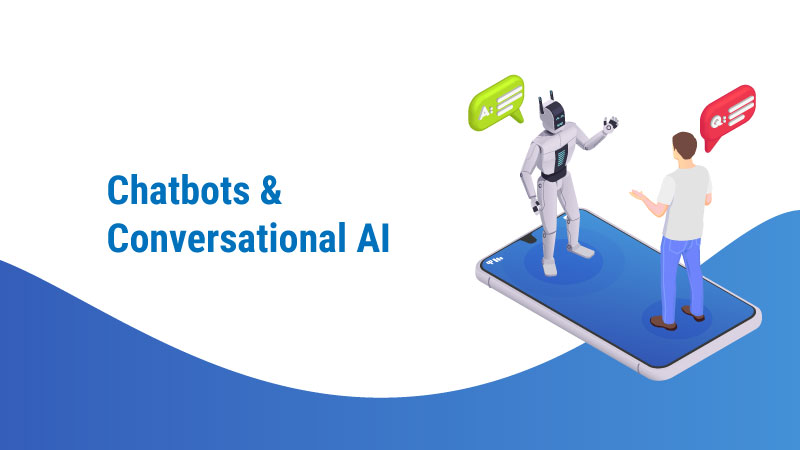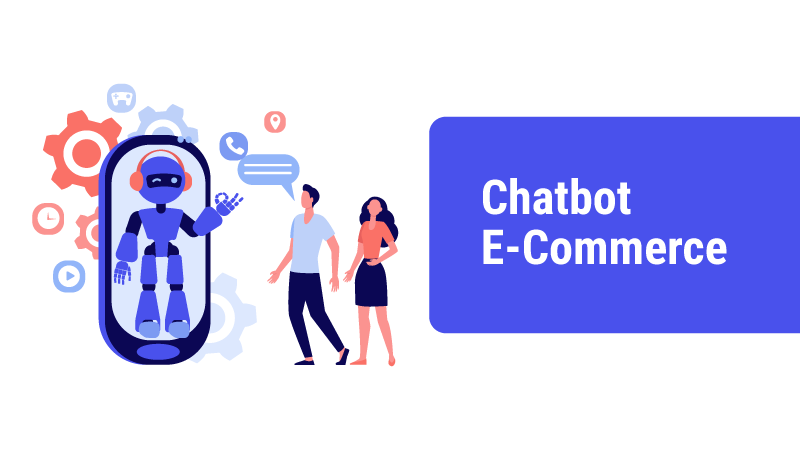Difference Between Chatbots and Conversational AI

Today personal and professional interactions are becoming more and more digitized. Such digital environments are essential for business-to-customer relationships to nurture. Technology has become more advanced and is getting advanced day by day, thus increasing effective communication between customers and computers. The customer-computer relationships are mostly backed by chatbots and conversational Artificial Intelligence. In this blog, let us talk about conversational AI and chatbots and delve deeper into the relationship between the two.
What is a chatbot?
A chatbot is recognized as a digital agent that uses simple technologies to initiate communication with customers through a digital interface. Chatbots are automated to ‘chat’ with customers through websites, social media platforms, mobile applications, etc. They are not complicated to build and do not require technical proficiency. Chatbots can be easily built with both development platforms and can be implemented on digital channels.
What is conversational Artificial Intelligence (AI)?
Unlike chatbots, conversational AI is not about rule-based interventions, they have a firm structure and mostly relies on ML (Machine Learning), NLP (Natural Language Processing), Input Analysis, and DM (Dialog Management) to offer a more dynamic and unrestricted user experience than chatbots. Conversational AI uses a dialog flow system to provide a more advanced and exceptional service experience in human-bot interaction. Simply put, it refers to a set of artificial intelligence technologies that facilitates’ intelligent’ communication between computers and humans.
Natural Language Processing (NLP)
Conversational AI generates responses using linguistic rules and by incorporating machine learning and contextual awareness. Artificial Intelligence can customize the responses given to customers and predict their needs rather than simply interpreting the request of a user. NLP also enables machines to understand and comprehend voice as well as text inputs. Meanwhile, on the other hand, chatbots depend mostly on algorithms and language rules to interpret the meaning of a question and to select a proper response using natural language processing.
Machine Learning (ML)
Machine learning enables machines to converse intelligently with the users and to learn and understand from conversations. In Conversation ML, Systems with conversational ML enable machines to use their conversations with users to make future conversation experiences better.
Dialog Management (DM)
DM’s mission is to initiate conversations with customers and help them satisfy their needs. It ensures that the necessary semantic representation has been filled and determines the performance of the system. DM reaches out to the Knowledge Database in order to find the exact information the user is searching for. Dialog Management involves the selection of policies and tracking of the dialog state, thus enabling the dialog agent to make tough and powerful decisions.
Input Analysis
It helps to evaluate the purpose of the input and then generates a response that matches the context of the situation, which is exactly what a human agent would do while handling a customer query. Input Analysis allows the machine to provide better recommendations and suggestions after analyzing the input information.
Conversational AI V/S Chatbots
We have discussed what Conversational AI and chatbots stand for. Now let us see what is the relation between the two.
Have you ever thought about what makes a chatbot converse like a human? Well, the credit goes to Conversational AI. Conversational AI, when implemented in chatbots, makes them smarter and more efficient. But the important fact to be noted is that not every chatbot has conversational AI induced in it. There are these traditional chatbots that can perform only a limited number of tasks, which usually involve responding to common FAQs. The increasing needs of large enterprises led to the implementation of conversational AI into chatbots, thus improving their functionality from merely being an answering bot to understanding human language and providing transactional functionality. Conversation AI enables you to perform much more things efficiently rather than translating web content into chatbot responses.
Differences between AI-driven chatbots and Traditional Chatbots
AI Chatbot – relies on Natural Language Processing, Machine Learning, and Input Analysis to give a personalized customer service experience.
Traditional Chatbots – rely on rule-based functioning or programmed conversational flow.
AI Chatbot – strong and non-linear interactions that go all the way to deliver an appropriate response to customers.
Traditional Chatbots – linear and pre-set interactions that do not go out of the scope.
AI Chatbot – learn and understand continuously from interactions and rapid repetition cycle. Adapts to the changing customer needs.
Traditional Chatbots – interpret the input information. The reconfiguration will be necessary to update or revise any pre-defined rule and conversation flow.
AI Chatbot – scalability is high. The conversational AI interface gets updated while updating the database and pages of the company.
Traditional Chatbots – take a lot of time to scale. Requires updations, maintenance, and revisions to be done manually.
AI Chatbot – handles a large amount of data from clients at a faster pace. Gives rapid solutions to problems.
Traditional Chatbots – rapid response but fails to respond to questions out of scope.
AI Chatbot – Dialog-focused.
Traditional Chatbots – Navigation-focused.
Why do Conversational AI chatbots outrun Traditional Chatbots?
Looking at the above-mentioned points, one can easily understand that conversational AI is way more interactive and has many advantages than a chatbot. Now comes the question ‘Why chatbots are still in the market?’. The answer lies in the specific needs of organizations with different sectors, sizes, and business models. For instance, let’s assume that you are a restaurant owner and you decided to implement a chatbot on your website. This way your users can easily order food, track the order and give feedback without even talking to the owner or any other representatives. The chatbot will deliver proper service as long as the user remains in the scope topic. Chatbots are enough for small and medium businesses and huge companies which aim to handle a single task.
Wrap Up
Most people deem that these two terminologies are supportive and complementary to each other. They can improve customer interaction and experience when these two terminologies are effectively integrated. While comparing chatbots and conversational AI, you will see what makes conversational AI chatbots the best choice for your business. The system takes time to set up and train but once set up, a conversational AI is basically superior at performing most tasks. Therefore, it is highly recommended for businesses to gain better customer satisfaction.
Blogs by Category
AppForms Artificial Intelligence Blockchain Call Centers Chatbots Cloud Computing Data Management Design Digital Marketing Digital Transformation Enterprise Applications FinTech Insights LowCode Development Microsoft Mobile Apps News Office 365 Robotic Process Automation Security SharePoint Software Development Web ApplicationHow Chatbot Benefits E-Commerce

2024-04-04 18:23:50